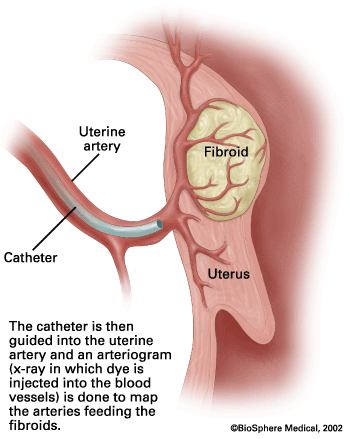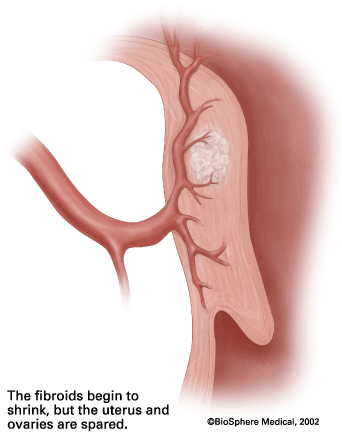 |
 |
![]() [Printer-friendly version -- PDF file, 617 Kb]
[Printer-friendly version -- PDF file, 617 Kb]
What are fibroids?
Why should women know about fibroids?
Who gets fibroids?
Where can fibroids grow?
What are the symptoms of fibroids?
What causes fibroids?
Can fibroids turn into cancer?
How do I know for sure that I have fibroids?
What is the treatment for fibroids?
How does Uterine Fibroid Embolization (UFE) work?
See also…
Uterine fibroids are tumors or growths, made up of muscle cells and other tissues that grow within the wall of the uterus (or womb). Although fibroids are sometimes called tumors, they are almost always benign (not cancerous). The medical term for fibroids is uterine leiomyomata (you-ter-in lie-oh-my-oh-mah-tah). Fibroids can grow as a single growth or in clusters (or groups). Their size can vary from small, like an apple seed (or less than one inch), to even larger than a grapefruit, or eight inches across or more.


Uterine fibroids are the most common, benign tumors in women of childbearing age, but no one knows exactly what causes them. They can be frustrating to live with when they cause symptoms. Not all women with fibroids have symptoms, but some have pain and heavy menstrual bleeding. Fibroids also can put pressure on the bladder, causing frequent urination.
More research is being done to figure out who is at risk for fibroids. But it is known that:
Doctors put fibroids into three groups based on where they grow, such as just underneath the lining of the uterus, in between the muscles of the uterus, or on the outside of the uterus. Most fibroids grow within the wall of the uterus. Some fibroids grow on stalks (called peduncles) that grow out from the surface of the uterus, or into the cavity of the uterus.
Most fibroids do not cause any symptoms, but some women with fibroids can have:
heavy bleeding or painful periods
bleeding between periods
feeling of fullness in the pelvic area (lower abdomen)
urinating often
pain during sex
lower back pain
No one knows for sure what causes fibroids. Researchers have some theories, but most likely, fibroids are the result of many factors interacting with each other. These factors could be hormonal (affected by estrogen levels), genetic (running in families), environmental, or a combination of all three. Because no one knows for sure what causes fibroids, we also don't know what causes them to grow or shrink. For the most part, fibroids stop growing or shrink after menopause. But, this is not true for all women with fibroids.
Fibroids are almost always benign, or not cancerous, and they rarely turn into cancer (less than 0.1 percent of cases). Having fibroids does not increase a woman's chances of getting cancer of the uterus.
Your doctor may find that you have fibroids when you see her or him for a regular pelvic exam to check your uterus, ovaries, and vagina. Often, a doctor will describe how small or how large the fibroids are by comparing their size to the size your uterus would be if you were pregnant. For example, you may be told that your fibroids have made your uterus the size it would be if you were 8 weeks pregnant.
Your doctor can do imaging tests, or tests that create a "picture" of the inside of your body without surgery, in order to confirm that you have fibroids. These tests might include:
Besides imaging tests, you also might need a surgery to know for sure if you have fibroids. These could include:
Talk with your doctor about the best way to treat your fibroids. She or he will consider a number of things before helping you choose a treatment. Some of these things include:
If you have fibroids, but do not have any symptoms, you may not need any treatment. But your doctor will check during your regular exams to see if they have grown.
Medications
If you have fibroids and have mild symptoms, your doctor might only suggest pain medication. Over-the-counter anti-inflammatory drugs, such as ibuprofen, or other painkillers such as acetaminophen can be used for mild pain. If pain becomes worse, your doctor can prescribe a stronger painkiller.
Other drugs used to treat fibroids are called gonadotropin releasing hormone agonists (GnRHa). These drugs can decrease the size of the fibroids. Sometimes they are used before surgery, to shrink the fibroids, making them easier to remove. Side effects can include hot flushes, depression, not being able to sleep, decreased sex drive, and joint pain. Anti-hormonal agents, such as a drug called mifepristone, also can stop or slow the growth of fibroids. These drugs only offer temporary relief from the symptoms of fibroids; once you stop the therapy, the fibroids often grow back.
Surgery
If you have fibroids with moderate or severe symptoms, surgery may be the best way to treat them. Here are the options:
Uterine Fibroid Embolization (UFE)
Uterine fibroid embolization (UFE) is a treatment that cuts off the blood supply to the uterus and the fibroids so they shrink. UFE is proving to be an alternative to hysterectomy and myomectomy. The recovery time is also shorter, and there is a much lower risk of needing a blood transfusion than for these surgeries. Many women can have UFE and go home the same day. There is a small risk of infection in the treated fibroid, but these are usually managed with antibiotics. Recent studies also suggest that most fibroid tumors are not likely to re-grow after UFE, although more long-term data is needed.
Not all fibroids can be treated with UFE. All patients must first be evaluated with ultrasound or MRI to make sure the fibroids will respond well to this treatment. Doctors called interventional radiologists perform UFE. The best candidates for UFE are women who:
Sometimes after UFE, the particles that are put into the fibroids to cut off their blood supply have traveled to the ovaries. In a few women, the ovaries then stop working for a short time or permanently. Although researchers know that UFE may affect how ovaries function, they are unsure of how exactly UFE affects fertility. If you want to have children in the future, you should talk with your doctors about the small, but definite risk of UFE causing you to go into early menopause. Too few women have gotten pregnant after UFE for researchers to know if there is an increased risk of pregnancy complications.




You can find out more about uterine fibroids by contacting the National Women's Health Information Center (NWHIC) at 800-994-9662 or the following organizations:
National Institute of Child Health and Human Development Clearinghouse
Phone Number(s): (800) 370-2943
Internet Address: http://www.nichd.nih.gov/publications/pubs.cfm
American College of Obstetricians and Gynecologists (ACOG) Resource Center
Phone Number(s): (800) 762-2264 x192 (Publications Requests Only)
Internet Address: http://www.acog.org/
National Uterine Fibroids Foundation
Phone Number(s): (877) 553-NUFF
Internet Address: http://www.nuff.org/
This FAQ was expert reviewed by Dr. Evan Myers, Associate Professor and Chief, Division of Clinical and Epidemiological Research, Department of Obstetrics and Gynecology, Duke University Medical Center.
All material contained in the FAQs is free of copyright restrictions, and may be copied, reproduced, or duplicated without permission of the Office on Women's Health in the Department of Health and Human Services; citation of the source is appreciated.
September 2004
Home | About Us | Contact Us | Site Index | Privacy Policy | Disclaimer | FOIA | Accessibility
Contact NWHIC
or call 1-800-994-WOMAN
NWHIC is a service of
the
U.S.
Department of Health and Human Services'
Office
on Women's Health